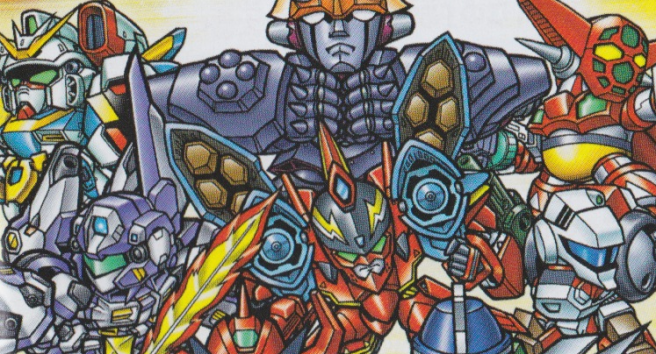[Famicompendium] Super Robot Wars D
So lately I’ve been hooked on a little game called Destiny. Like many others, I got sucked into its futuristic world and addictive gameplay of upgrading weapons to shoot down waves of aliens. Sure, sometimes fights take far too long, but it’s still quite impressive for a Game Boy Advance game. Yep, Super Robot Wars Destiny (D for short) is one interesting strategy RPG and a good jumping-off point for discussing the Super Robot Wars series as a whole. Hope you like giant robots!
What makes the Super Robot Wars titles fascinating to me is the way in which they mix together various robot-centric anime characters and storylines into one cohesive crossover game. In other words it’s officially sanctioned fan-fiction masquerading as a strategy RPG. Confusingly, two of the GBA entries in the series were released in the US with the Japanese title “Super Robot Taisen”, probably to avoid any legal issues with a certain similarly named TV program (real talk: a strategy RPG featuring the likes of Sergeant Bash and Sir Killalot would be awesome). Despite featuring the same gameplay mechanics, these “Original Generation” games were centred entirely on original characters free from any messy anime licenses, which is probably why they never clicked with me. Sure, taking turns leading militias of mecha into battle with each other is a decent enough premise for a game, but the thrill of seeing the likes of Gunbuster and Gurren Lagann team up and be faithfully adapted to an RPG form is the big draw of the series for me. I can’t think of any equivalent in western media that doesn’t involve teaching kids about the dangers of marijuana. The Super Robot Wars games are those rare licensed games that are not only perfectly playable, but totally get the appeal of the source material and adapt it in interesting ways.
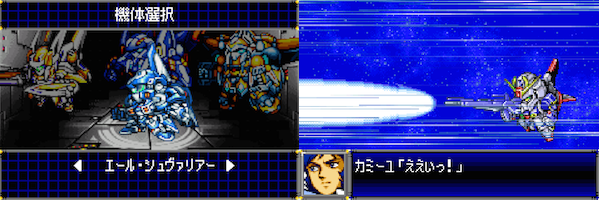
The earliest entries in the series were developed by Winkysoft, a company who worked on a number of other titles based on anime properties (as well as Doctor Lautrec and the Forgotten Game). The original Super Robot Wars was released for the Game Boy in 1991 and featured playable robots from just three franchises – Mobile Suit Gundam, Getter Robo and Mazinger Z. Even now, most games in the series feature these three franchises, but tend to feature different takes on them. Super Robot Wars D uses the infinitely more watchable Getter Robo Armageddon instead of the usual ‘70s TV series, for example. This original Super Robot Taisen game (which actually got a HD remake earlier this year) is a bit of an anomaly – enemy robots can be recruited to your side and instead of featuring an original storyline, the game’s plot is lifted straight from the Great Mazinger vs. Getter Robo crossover anime.
Winkysoft continued releasing Super Robot Wars games on the Famicom, Super Famicom, Playstation and Saturn, gradually adding in a mix of anime series both old (Aura Battler Dunbine, Zambot 3) and not as old at the time (Evangelion, Gundam Wing). Though still a mashup of various anime plots, these games featured original characters and storylines, many of whom would return in Winkysoft’s Masou Kishin RPG series, which is still running. The series was handed over to internal teams at Banpresto during the late nineties; the resulting output improved on the dated visuals and clunky mechanics of Winkysoft’s games. Of these more modern interpretations of the Super Robot Wars formula, the higher budget Alpha and Z series of games stuck to the Playstation, while Nintendo’s consoles (particularly handhelds) hosted a number of self-contained “B-Team” games and some bizarre spin-offs. And so, that brings us to Super Robot Wars D. Though considered one of the lesser Super Robot Wars games thanks to some nasty bugs, wonky difficulty scaling and graphics that aren’t all that great even by GBA standards, I still find it to be one of the most intriguing entries in the series – on a Nintendo console, at least.

Part of the reason why Super Robot Wars D stands out to me is the cast and setting. On top of the usual suspects, this entry introduces Getter Robo Armageddon, Macross 7, Megazone 23, Daltanious and The Big O, which features its Queen rip-off theme song for the only time in the series. The game is set in the far future following the story of the original Macross and Mobile Suit Gundam. This means that plenty of earthlings are settling in space colonies or roaming the galaxy in search of more planets to populate. Meanwhile, the Earth has been reduced to a post-apocalyptic wasteland thanks to the events of Getter Robo Armageddon. The story begins shortly after this cataclysm, with Mobile Suit Gundam’s Char about to unleash his Counter-attack on Earth by dropping an asteroid, only to find the planet disappear completely. Why exactly would be want to obliterate an already devastated Earth? Well okay, there are a few plot holes, but this sudden disappearance is an interesting plot hook.
Depending on choices made in the prologue, the main character Joshua or his sister Rim either remain on the sealed Earth or stay out in space and wonder what the heck is going on. This split allows the game to focus on introducing the different anime series, with the Earth route dealing with entries like Victory Gundam and Getter Robo, while the adventures in space follow Macross 7 and Char’s Counterattack. The two routes continue to merge and split throughout the story, and the game needs to be played through at least twice to piece together everything that’s going on. Eventually the Earth is unsealed, with a bunch of interdimensional beings called the Ruina manipulating things behind the scenes, and so the heroes from each series (and a couple of antagonists) team up to take down the threat on top of all the alien invaders and evil empires they were already waging war against.

It’s neat to see the characters from each series interacting with each other, whether that involves Roger “Batman” Smith from the Big O negotiating with various political entities or Relena Peacecraft from Gundam Wing lecturing the evil Emperor Zuul. The only anime that doesn’t quite fit is Megazone 23 since the show is essentially set in the Matrix only everyone is permanently stuck in the 1980s. The game’s justification of this by having them come from an alternate dimension is a bit awkward, but it’s interesting to see the characters come to terms with the fact they’re actually on a post-apocalyptic Earth where every member of Duran Duran is dead. Despite the rather bleak setting, Super Robot Wars D still concludes on a far more uplifting note than most of the anime series it includes. This seems to be a trend for the rest of the Super Robot Wars games as the darker fare is usually relegated to alternate endings. It makes sense, I guess; of course Shinji from Neon Genesis Evangelion would get over his depression if he was constantly surrounded by hot-blooded super robot pilots. The massive scope of the crossover lends itself to “what-if?” scenarios and allows the writers to gloss over filler episodes and some of the weaker aspects of individual plots.
Since the power of most of these anime robots tends to be determined by the pilot’s hot-blooded screams than any sort of logic, Super Robot Wars features a unique “willpower” stat that fluctuates based on the flow of battle. Shoot down enough enemies and it’ll amp up the unit’s damage and unlock their most powerful attacks. There’s quite a bit of complexity to Super Robot Wars’ strategy segments. Not only do the stats of both individual pilots and their robots need to be taken into account, but there are also plenty of customisable skills, bonuses based on characters’ relationships, terrain effects and combination attacks. Some robots transform, some can combine with each other; there are even colossal battleships that can transport troops, but if they get shot down it’s an instant game over. Probably the most creative units in Super Robot Wars D come from the wonderfully bizarre Macross 7. Since the protagonist is a pacifist who spends most of the series jamming out in his cool robot (operated with a Guitar Hero controller because Macross 7 is awesome), instead of conventional attacks he grants various buffs to surrounding units through the power of rock.
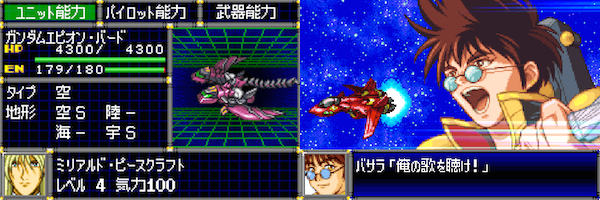
Through gaining experience and levelling up, pilots increase their stats and gain access to several different “spirits”. Usually these have some basis in character traits – those more romantically-inclined cast members might gain access to the powerful “Love” spirit, for example. These special abilities allow characters to heal, increase damage, dodge attacks or even self-destruct, but they need to be used sparingly as they’ll quickly drain the pilot’s “SP”.
Though it might have “super robot” in the title, Super Robot Wars divides units roughly into “super” and “real” categories, which have various implications on gameplay. Since some shows strive for realism (well, as realistic as a giant robot can get), smaller units like Gundams and Macross’ Valkyries sacrifice power and armour for increased hit and dodge rates. Conversely, the really giant robots like Mazinger Z and, er, Giant Robo can take on any enemy with their massive bulk, but might need a bit of help to actually hit anything. That’s how the system is supposed to work, anyway. Super Robot Wars D happens to have a rather nasty bug that ignores some of the super robots’ advantages, meaning that attacks tear through their armour like the Victory Gundam tears through suicidal bikini babes. Oh well, who’d want to use a lame Voltron-wannabe like Daltanious anyway?
Generally the games’ difficulty levels are balanced in such a way that players can field whichever robots they want, regardless of how useful they are, but in Super Robot Wars D this isn’t really possible. Usually the games’ lack of challenge is offset by several optional objectives that unlock various secrets. Super Robot Wars D lacks these additional goals, but there are still plenty of secrets to uncover – from hidden robots to characters who would usually die in their story lines.
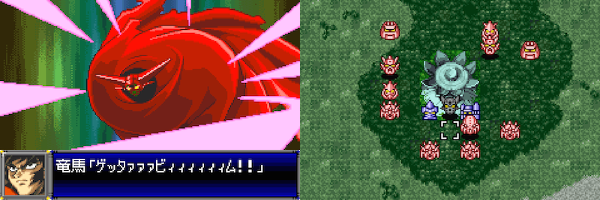
While most of the game consists of commanding units from a top-down perspective (or snazzy isometric view in the more recent console entries), launching an attack switches to the game to a 2D view of the robots duking it out. The spritework in these scenes is usually excellent, especially in the newer games; you can tell a lot of effort went in to making sure each robot and their attacks perfectly captures the look of the original anime. Yes, the games tend to use super-deformed versions of the robots, which are apparently cheaper to license, but they still have an attention to detail which few other sprite-based games can match. Some Super Robot Wars games attempted to use 3D models, but these tend to be among the lower-selling entries in the series. Funnily enough, I find that the series’ conversions of shows that used fancy 3D animation like Macross Frontier and Aquarion tend to look much better when represented as 2D sprites, though I’m not sure if that says more about the quality of the spritework or Japan’s janky CGI. Super Robot Wars D is hardly one of the best-looking games in the series since the robots just kind of glide into each other, but there are some neat effects and the occasional cut-in to keep the battle scenes dynamic. Besides, in some cases cutting corners with the animation keeps the game even closer to the source material.
This commitment to authenticity extends to the games’ audio. Each beam rifle shot or weird newtype flash sound is replicated as well as the sound hardware will allow. Though Super Robot Wars D and most of the other portable entries lack any sort of voice acting, they still have a heap of licensed songs from the array of anime shows represented. While some pieces sound like junk coming out of the GBA’s speakers, others are excellent renditions with a quicker tempo that makes them ideal for battle music. Really the only real problem with D’s soundtrack is that it lacks earlier entries’ “karaoke mode”. I find that the arranged music loses a bit of a bit of charm the closer the games get to replicating songs from the anime, but the original compositions are still good, not to mention the frequent appearances from JAM Project performing each game’s theme music.
Though Super Robot Wars D is an immensely enjoyable adaptation, certainly by the standard of licensed games, I’d hesitate to call it the ideal way to enjoy the anime it presents. The most attractive aspect of the game to me – the sheer scope of it all – ends up being Super Robot Wars’ biggest weakness. There’s simply too many different intertwining storylines to reconcile, and while the writers do an admirable job of making everything fit together, the rushed nature of the individual narratives lessens their impact. The fact that the game is driven by dialogue rather than action means that otherwise emotional scenes are just represented by a series of talking heads. Sure, it might be nice to go through a less-idiotic version of Gundam Wing skipping all the stock footage and keeping Wufei permanently benched, but then you’d miss out on moments like General Septum getting thrown out of a plane and shot in midair.
The overwhelming amount of anime series included also makes the gameplay quite tedious. There are just too many units to field and too many different enemy factions to pit them against. What starts as a short skirmish ends up taking seemingly forever as several antagonists join the fray with their own set of reinforcements. Granted, some Super Robot Wars games deal with the massive cast by giving experience to benched pilots or sorting robots into squads, but this just adds another level of micro-management. Too much content can be a bad thing, and with its repetitive objectives and multiple storylines, the Super Robot Wars games often come off as bloated; a title that’s a bit too epic for its own good. Though Super Robot Wars D is one of the shorter games in the series, other entries clock in at around sixty stages. When it takes over an hour to clear a mission even when skipping animations, that’s one doozybot of a game.
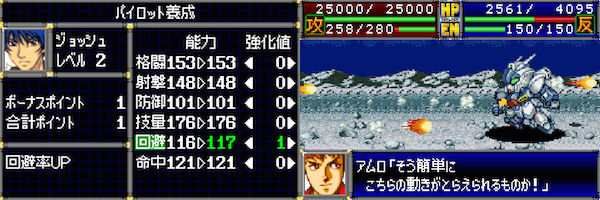
But still, I’d call Super Robot Wars D a solid adaptation. While lengthy, it is definitely a far quicker experience than actually watching through all the anime series it draws plot points from. Even though the presentation doesn’t always lend itself well to dramatic moments, the process of influencing the narrative and seeing the characters interact adds to the source texts and creates something unique. Sure, it’s not as mechanically interesting or challenging as, say, Fire Emblem or Final Fantasy Tactics, but that’s not really the point. Super Robot Wars D and the series in general aims to pay tribute to the crazy world of animated giant robots both old and new and in that sense it’s a truly exceptional experience.
Import Friendliness: Moderate
Since a lot of the fun comes from seeing how the different series play out in relation to each other and how the cast interacts, you’d miss out on a lot without decent Japanese comprehension. But still, the basic gameplay and menus are so similar between games that it isn’t too difficult to actually play it. As a fairly popular series, there are plenty of translation guides and story summaries out there on the net. A couple of entries even have full fan translations like Super Robot Wars J and Alpha Gaiden (of course, there are also the two GBA Original Generations games). Just don’t go holding out for an official English release any time soon. I mean Tatsunko vs. Capcom made it over, but those guys didn’t have to deal with Harmony Gold.
Next time on Famicompendium I try to make up for lost time with not one, not two, but three games. Wow.
